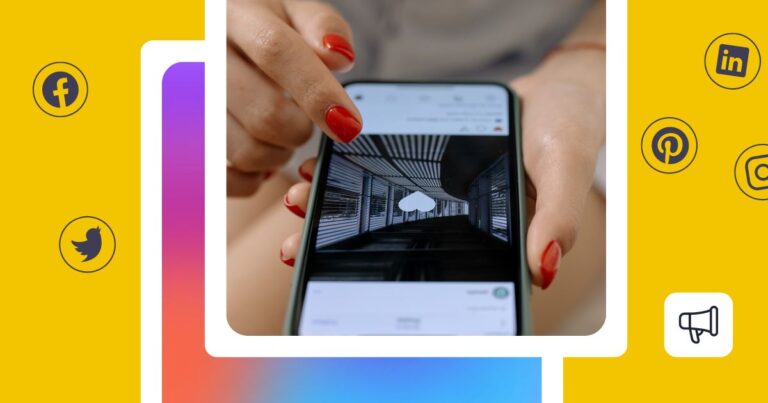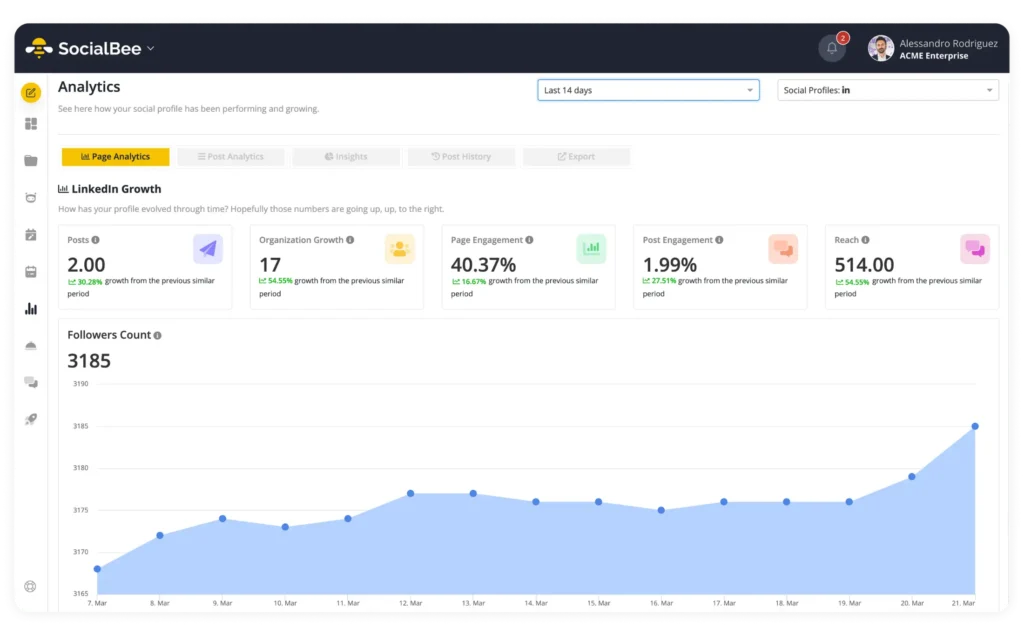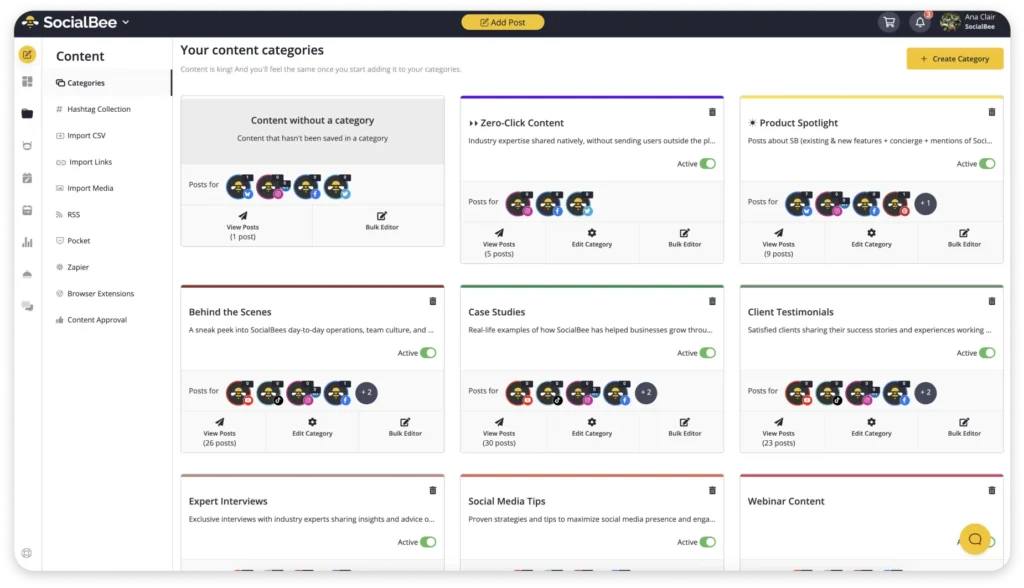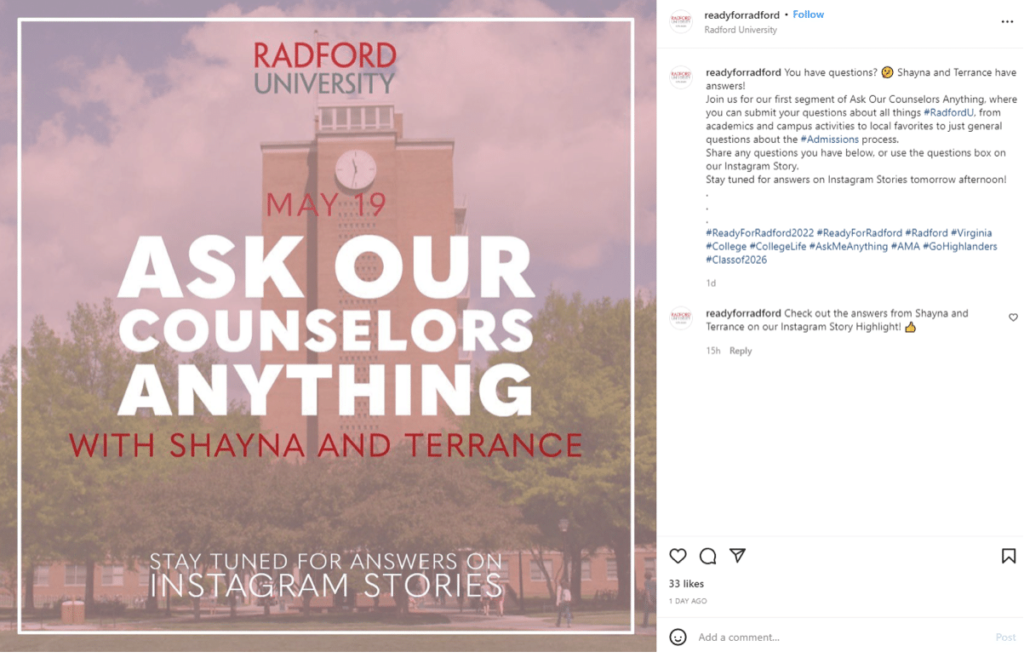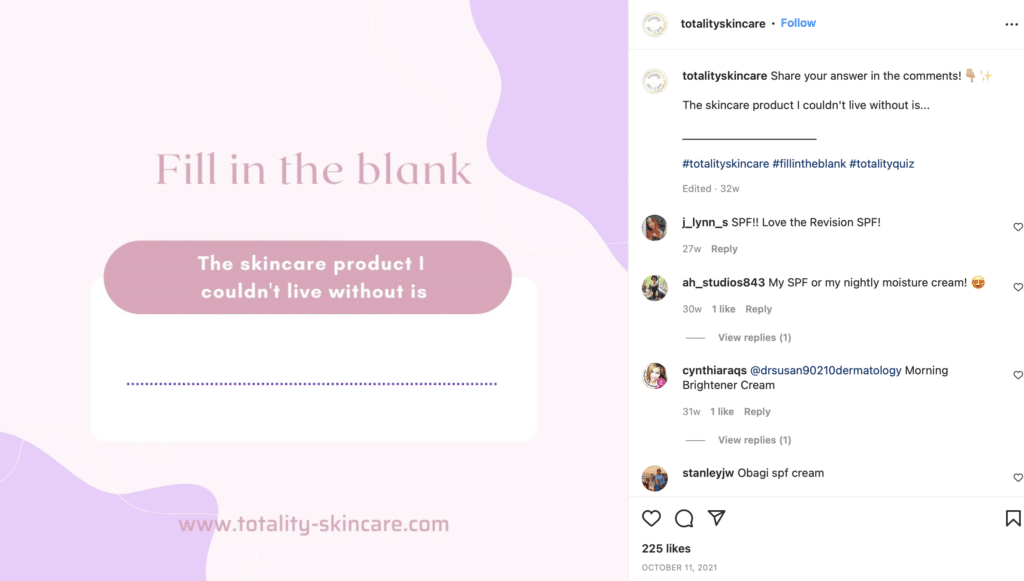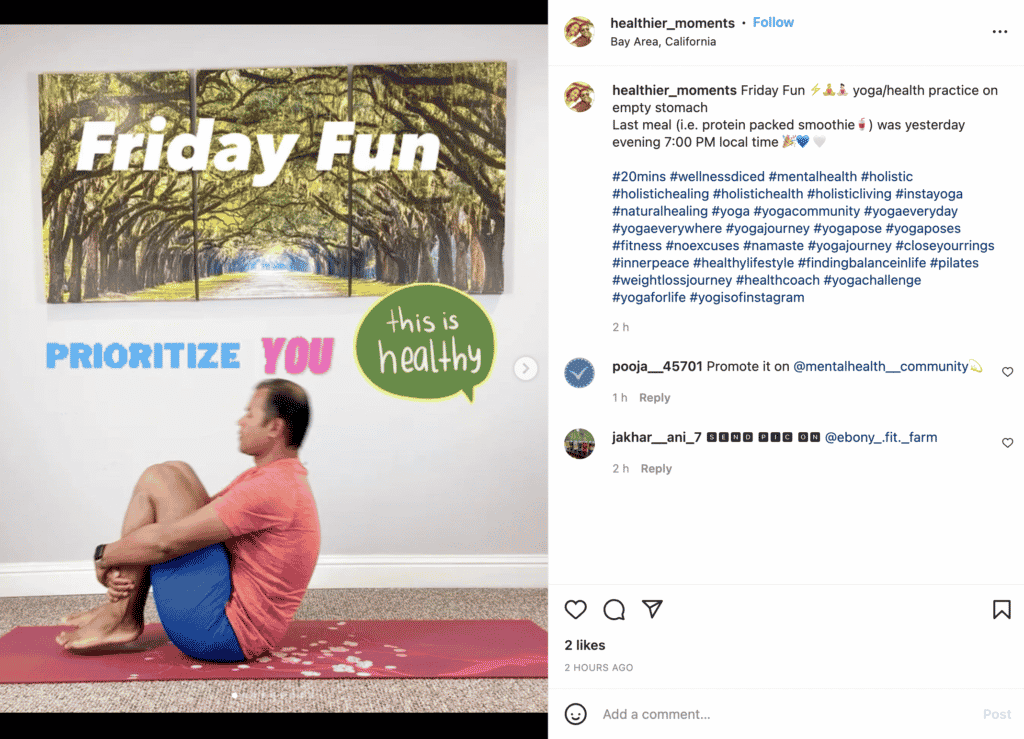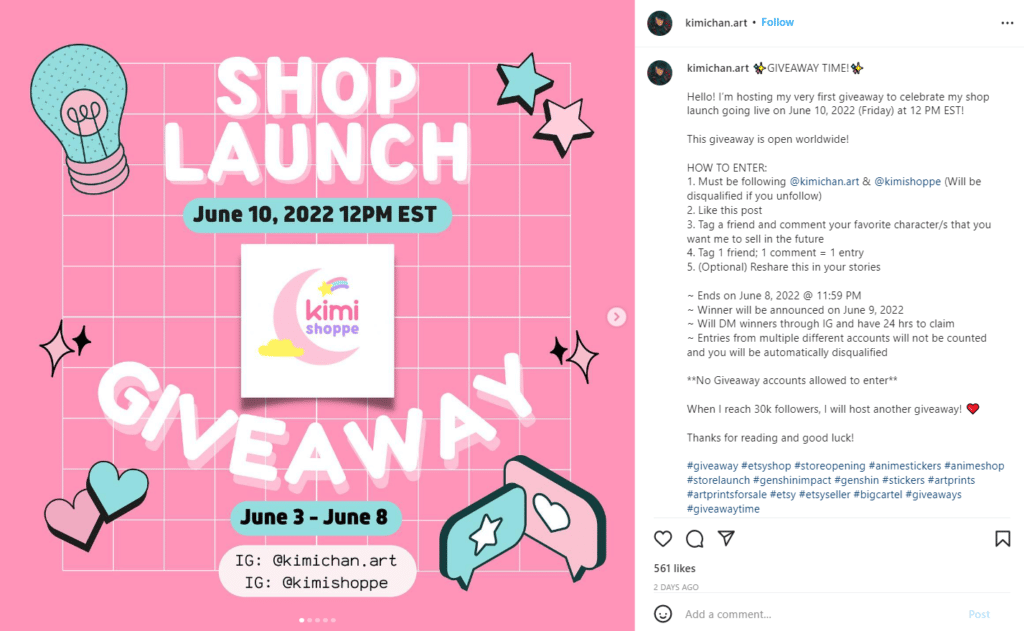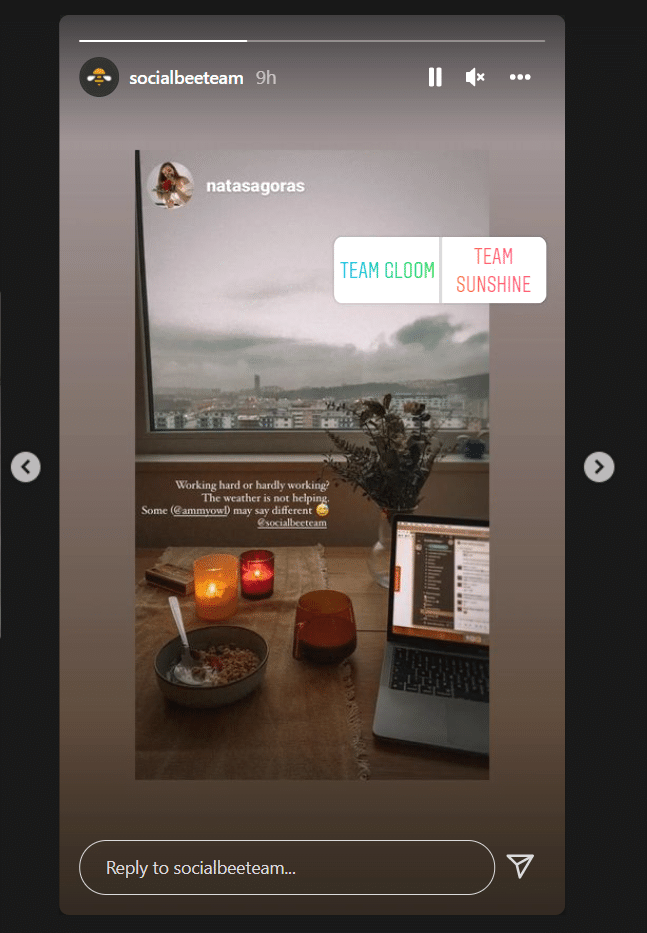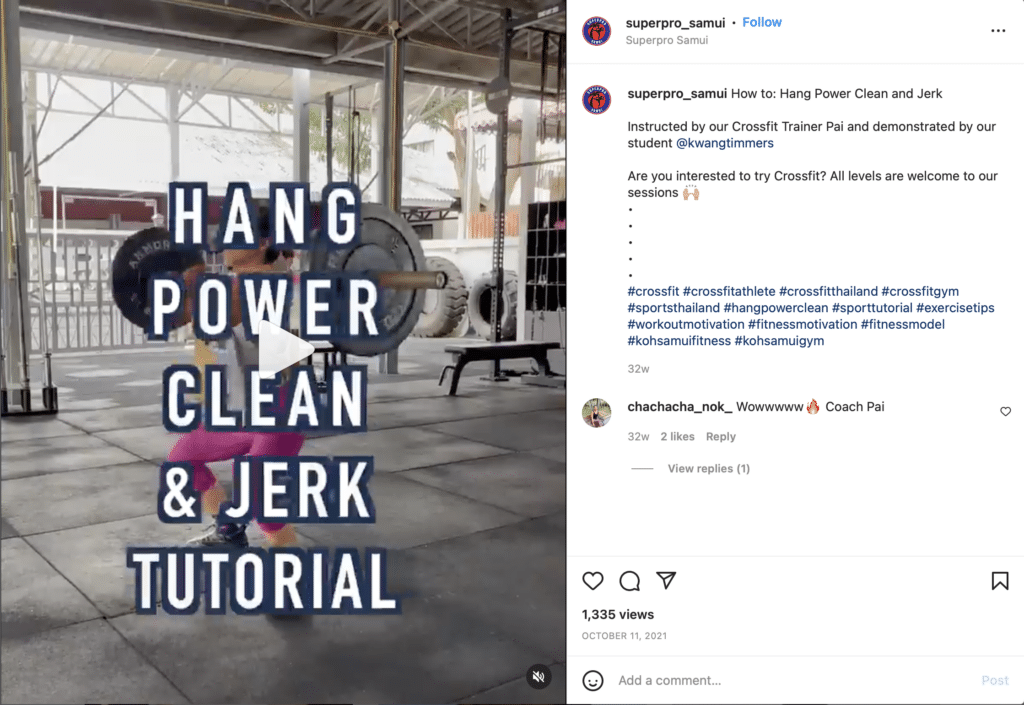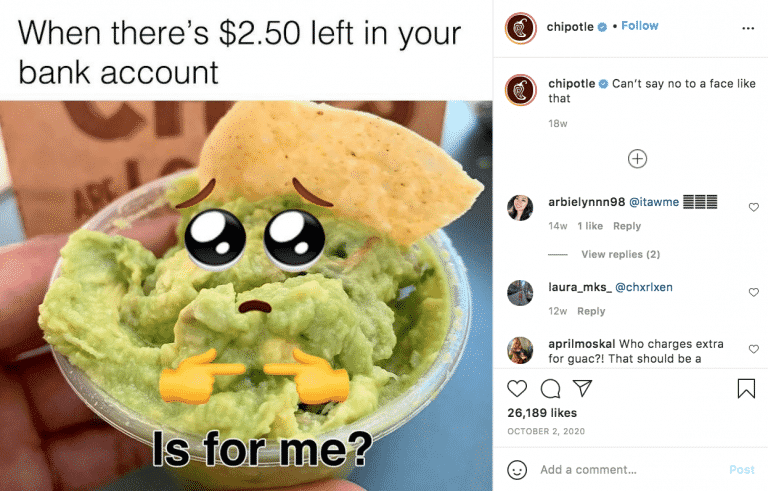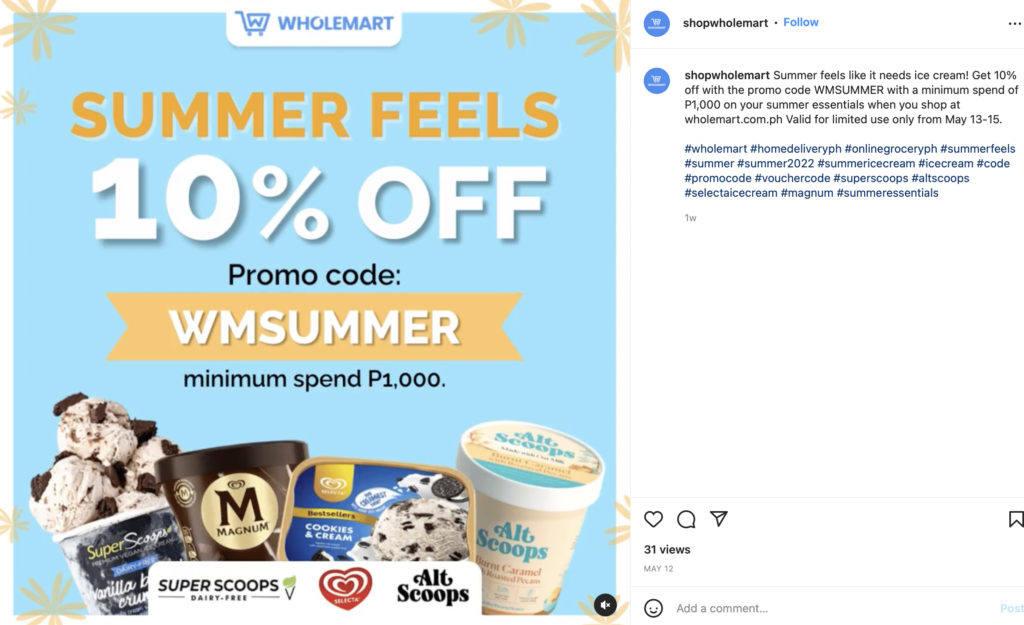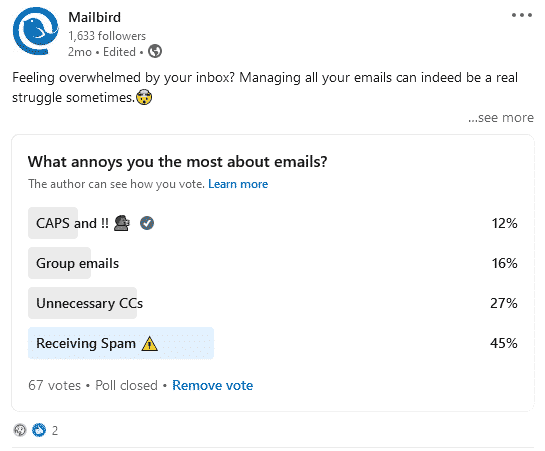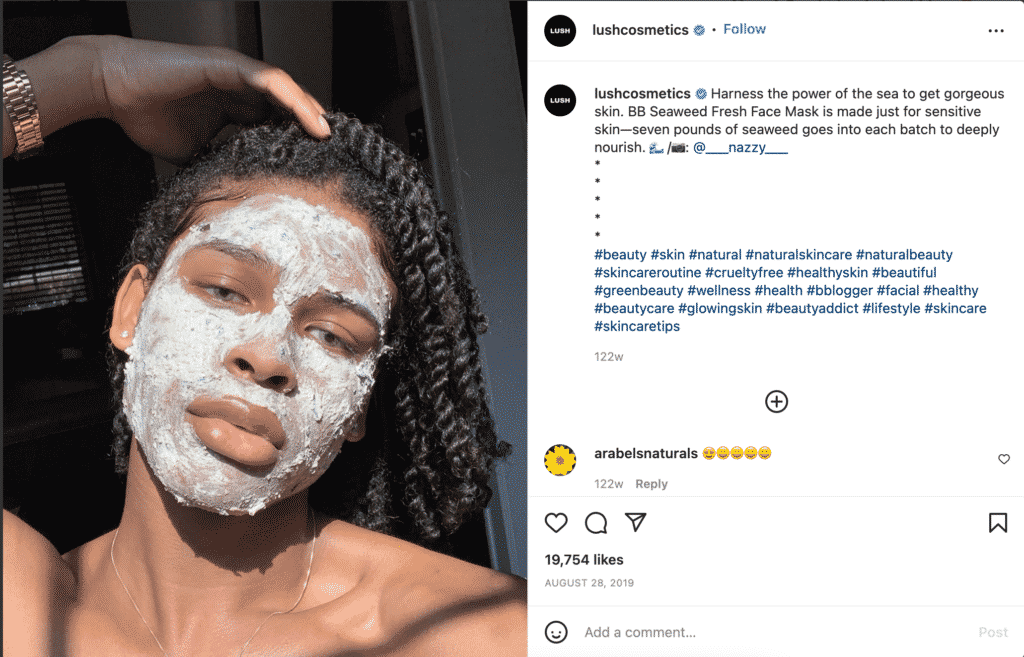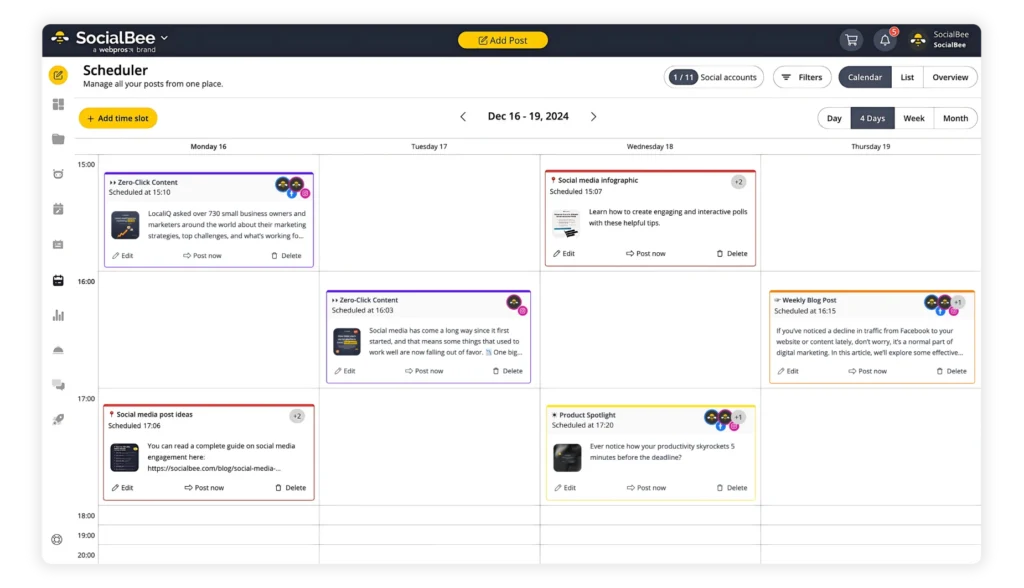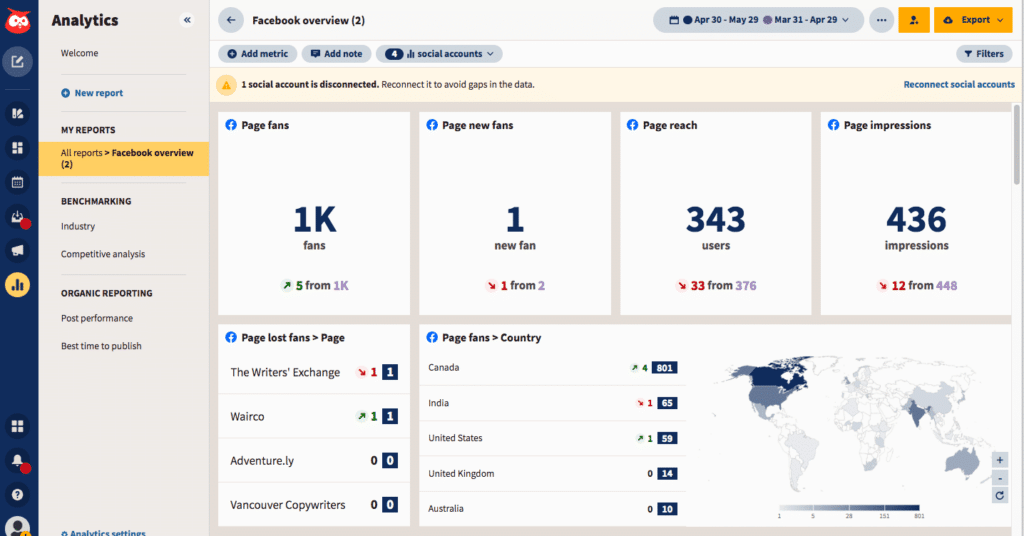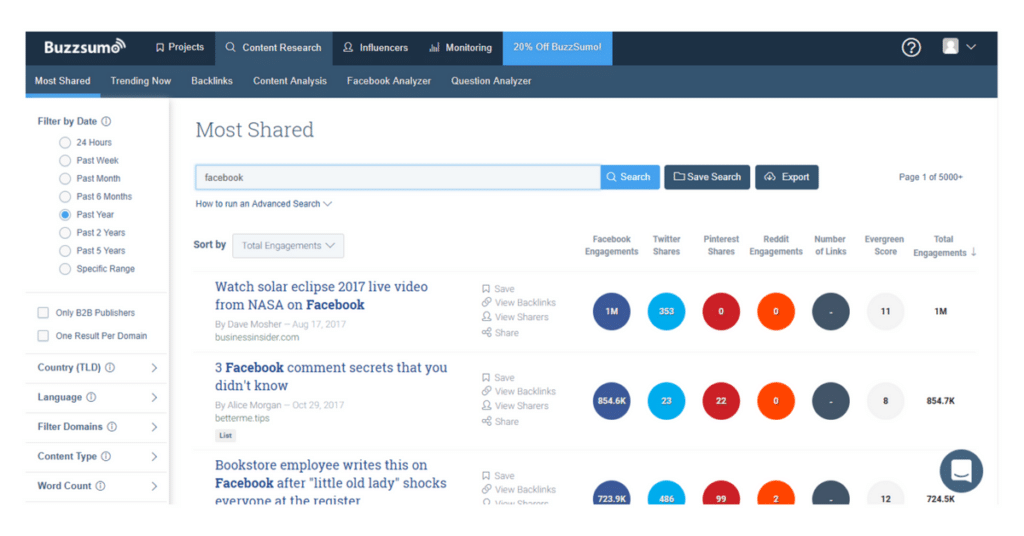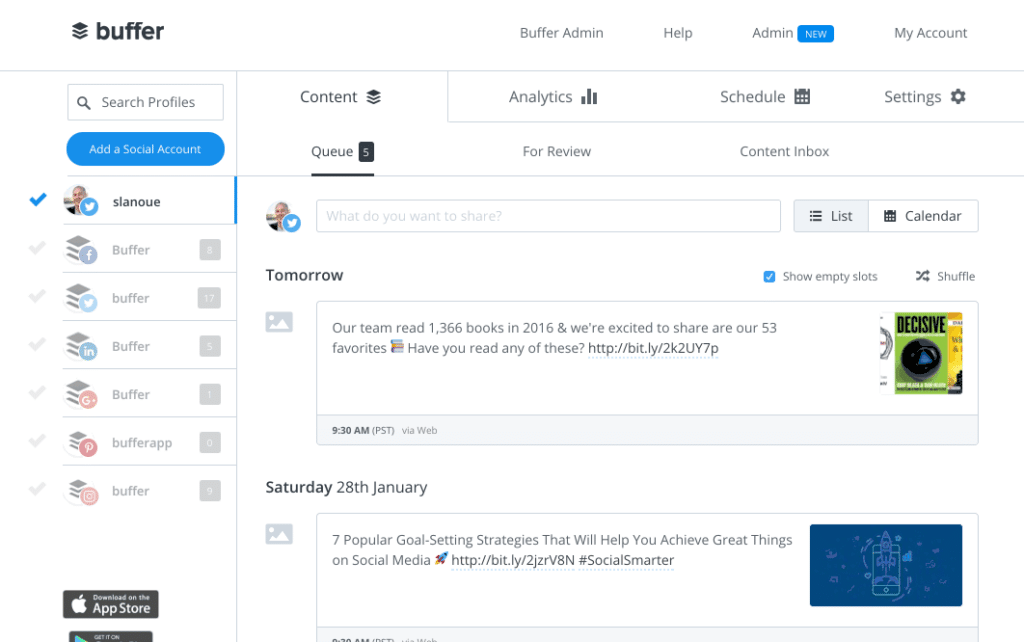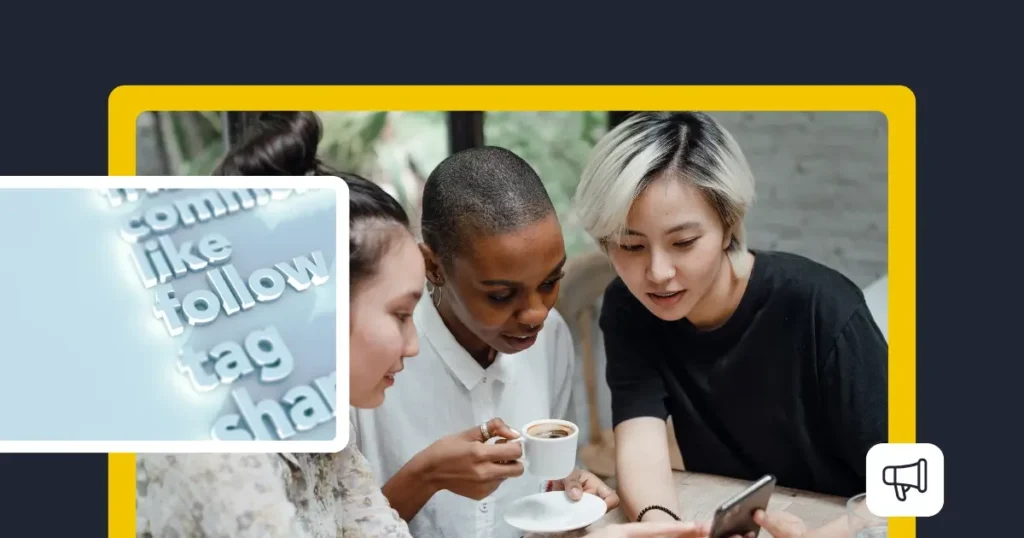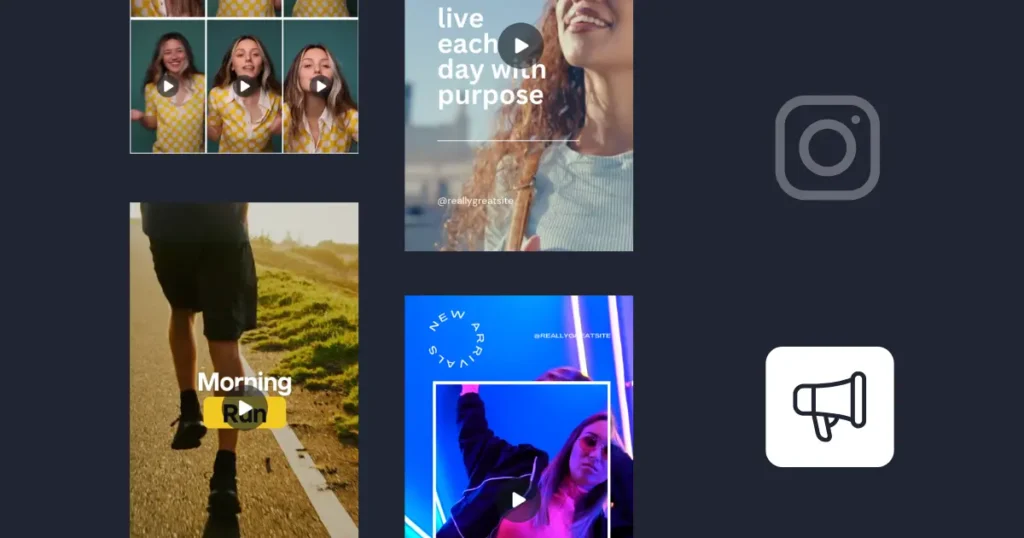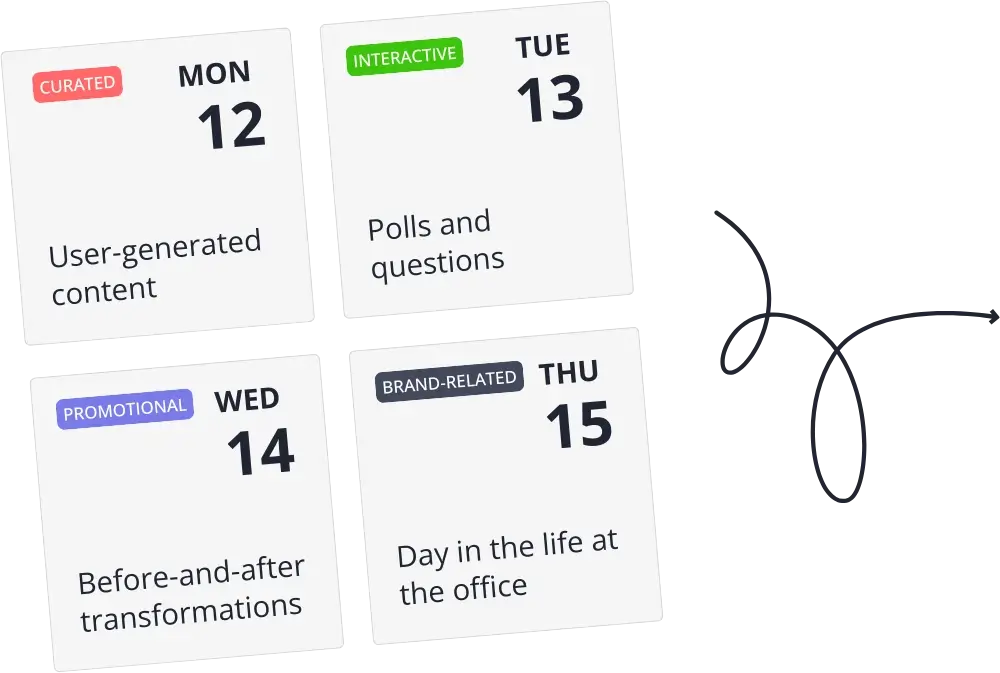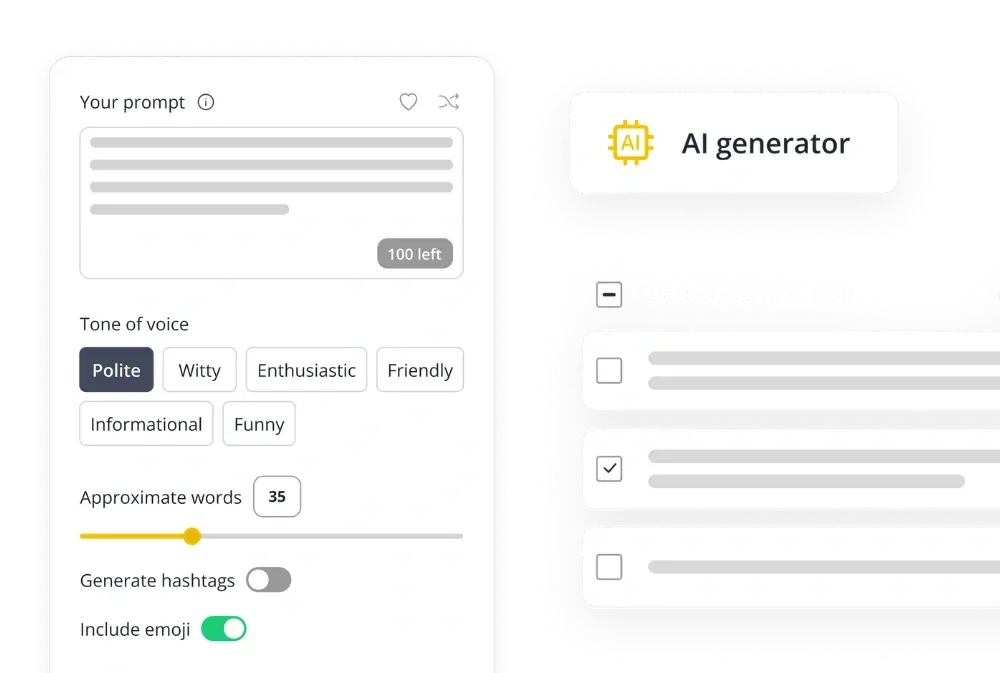
Content Writer at SocialBee
Running a social media account (or many) on top of your professional responsibilities isn’t exactly a walk in the park, but if you’re truly committed to growing your online profiles, you’ll have to get serious about your social media engagement.
If you already have several social media profiles in place, you’re halfway there! All you have to do now is learn to optimize it so that your audience finds it easier to connect and relate to the brand’s personality. How?
There are a few ways to do so manually, but no one has the time for this amount of social media efforts. Instead, automating your social media engagement posts through a specialized app and a detailed social media strategy is the key.
Ready to find out more about social media engagement and how to boost it? Keep on reading!
We’re SocialBee LABS SRL, part of WebPros. We use the information you provide to share relevant content and product updates, as outlined in our Privacy Policy. You can opt out anytime.
Short Summary
- Social media engagement helps create a sense of community by encouraging two-way communication. This interaction makes your audience feel involved and valued, strengthening their connection to your brand.
- Content that generates likes, comments, and shares is prioritized by social media algorithms. This increased engagement extends your reach, making your content visible to a broader audience.
- Engaging with your audience provides immediate insights into their preferences and opinions. This feedback is crucial for refining your content strategy to better meet their needs.
- Regular, authentic interaction with your audience builds trust. When followers see that a brand is responsive and engaged, they are more likely to develop loyalty and remain long-term supporters.
- Engaged followers are more likely to become customers. Each interaction enhances their interest in your products or services, increasing the chances of conversion.
- Utilize social media management tools to streamline your engagement efforts. Tools like SocialBee offer features for scheduling posts, monitoring interactions, and analyzing performance, saving time and boosting engagement.
Table of Contents
- What Is Social Media Engagement?
- Why Is Social Media Engagement Important?
- The Different Types of Social Media Engagement
- How to Measure Social Media Engagement
- How to Increase Social Media Engagement Organically
- 10 Social Media Engagement Posts Ideas
- 1. Post AMAs (Ask Me Anything)
- 2. Share “Fill in the Blanks” and “Caption This” Posts
- 3. Create a Weekly Series
- 4. Run a Contest or Giveaway on Your Social Media Platforms
- 5. Post Content on Facebook, Instagram and TikTok Stories
- 6. Share How-to Posts and Tutorials
- 7. Create Memes and Fun Posts
- 8. Run Social Media Exclusive Deals
- 9. Post Polls and Questions
- 10. Promote User-Generated Content
- Top 5 Social Media Engagement Tools to Use
- Frequently Asked Questions
- Improve Your Social Media Engagement Strategy
What Is Social Media Engagement?
Social media engagement is a way of tracking interactions on social platforms, such as likes, shares, saves, comments, and other engagement metrics.
Picture this scenario: You’re scrolling through your Instagram feed and stumble upon a recipe that you love. Naturally, you double-tap on it, share it on your story, save it so that you can review it later, and maybe even tag a few friends or co-workers to see it.
That’s social media engagement! And it should be an important part of your social media marketing strategy!
Engagement is measurable, which means that you can assess how your posts are doing by looking at the performance insights on your platforms.
Engagement also refers to the direct interaction with your audience, such as replying to messages, comments, and mentions.
Why Is Social Media Engagement Important?
Social media engagement is an indicator of how your audience connects with your content, helping you creating a community around shared interests or values.
Here is why social media engagement is important:
- Community building: Interacting on social media is not just about sending out messages; it’s about starting conversations. This back-and-forth helps build a solid connection with your audience, making them feel like they’re part of a community instead of just watching from the sidelines.
- Visibility and reach: When potential customers engage with your content by liking, commenting, or sharing, it naturally extends your reach. This is because social media sites are designed to favor content that generates interaction, showing it to more people.
- Direct feedback: Engaging with your audience gives you direct insights into what they like or dislike. This feedback is super important as it allows you to adjust your approach to better meet the needs and interests of your audience.
- Loyalty and trust: Regular, genuine interaction with your audience can significantly boost loyalty. When people see that a brand is active and responsive on social media, they’re likely to trust it more and follow their content.
- Enhanced credibility: Meaningful engagement can serve as social proof, indicating that your content is worthy of attention. High levels of engagement show newcomers that you are established and respected in your field.
- Conversion opportunities: Engaged followers are more likely to convert into customers. Every interaction increases the likelihood that followers will want to learn more about you or your product, potentially leading to a purchase.
The Different Types of Social Media Engagement
Social media engagement is all about building strong connections online. It covers the different ways people interact with content, helping brands and individuals connect with their audience.
Here are the most common types of social media engagement:
- Content engagement
- Conversational engagement
- Community engagement
- Transactional engagement
- Support and service engagement
1. Content Engagement
Content engagement means getting users to interact with your brand actively by liking, sharing, and commenting on your posts.
Use polls, surveys, and quizzes to invite users to share their opinions and have fun, making them more likely to share your content.
Multimedia content like multiple images, short-form videos, and live streams captures attention and encourages interaction. Stories on Instagram, TikTok and Facebook, and user-generated content add authenticity and variety to your feed.
Combining these elements keeps your audience engaged and your feed dynamic.
2. Conversational Engagement
Conversational engagement includes direct interactions such as Direct Messages (DMs) for private chats and live chats during streams.
These real-time customer conversations foster personal connections and immediate feedback. As a small business owner, you can already implement their actionable insights in your business strategy.
3. Community Engagement
Community engagement involves participating in groups and forums around shared interests.
Users engage in discussions, share experiences, and attend virtual or in-person events, fostering a sense of community.
4. Transactional Engagement
Transactional engagement occurs when users interact with content that leads to purchases or donations.
Social commerce features on platforms allow users to shop directly from posts, and fundraising campaigns enable easy contributions to causes. That will help you generate more engagement.
5. Support and Service Engagement
Support and service engagement focuses on helping users in a timely manner through customer service interactions.
Users seek assistance via comments, DMs, or support handles, building trust and brand loyalty through responsive service.
How to Measure Social Media Engagement
Measuring social media engagement helps you understand how your audience interacts with your content. By tracking likes, comments, shares, and more, you can see what works and improve your marketing campaigns.
Here’s what you need to know about measuring your engagement level on social media:
A. How to Calculate Social Media Engagement Rate
Calculating social media engagement rate involves assessing the total number of interactions your content receives relative to your audience size.
First, define what counts as engagement, such as likes, comments, shares, and clicks. Collect data on the total number of these engagements and the total number of posts for the period you’re analyzing.
Note the total number of followers or reach of your posts.
The basic formula for engagement rate is:
Engagement Rate = (Total Engagements/Total Followers)×100
For instance, if you have 500 engagements and 10,000 followers, your engagement rate would be 5%.
B. Social Media Engagement Metrics
Social media engagement covers all the ways users can interact with content across different platforms. Each type of engagement matters in its own way and plays a unique role in the metrics that content creators and marketers keep an eye on.
The main types of social media engagement metrics are:
- Likes: A simple way for users to show they like your social media campaigns, which helps more people see it and shows it’s popular.
- Comments: More interactive than likes, comments provide feedback and get conversations going, showing how engaging social media posts can be.
- Shares: Users share content with their followers to spread the word, which increases its reach. Create shareable content to ramp up engagement.
- Saves: On platforms like Instagram and Pinterest, when someone saves a post, it means they think it’s worth coming back to.
- Clicks: Clicks are key for content with links or calls to action, as they show how interested users are and that your posts are engaging.
- Mentions and Tags: When users mention or tag your brand, it not only broadens your reach but also draws in new audiences to interact with your brand or profile.
- Follows: A follow is a big deal—it shows someone is really into your profile and wants to see more of what you’re putting out there.
- Views: For video content, the number of views shows how far your reach is and can affect how visible your content is on the platform.
PRO TIP:
SocialBee provides insightful information about your post reach and engagement levels (clicks, likes, comments, and shares).
Moreover, it also shows your top-performing posts and lets you know what post format had the best results on your account (e.g. images, links, videos).
Use SocialBee’s analytics dashboard to measure post metrics in real-time.
How to Increase Social Media Engagement Organically
Looking to ramp up your social media engagement without paying for ads? It’s all about smart, organic strategies that resonate with your audience.
Below, you’ll find some effective ways to naturally boost interaction and strengthen your connection with your followers.
Here are some social media engagement ideas:
- Know your target audience
- Encourage your followers to interact
- Create a weekly series of Facebook posts
- Run a contest or giveaway on your social media platforms
- Post content on Facebook and Instagram stories
- Share how-to posts and tutorials
- Create memes and fun posts
- Run social media exclusive deals
- Post polls and questions
- Promote user-generated content
1. Know Your Target Audience
Before you jump to create eye-catching visuals and think about captions for your new content, you’ll have to define your target audience. Essentially, you’ll have to know who you’re addressing.
Start by establishing your brand guidelines (tone of voice, visual assets, main messages, mission, etc.) according to your audience’s preferences and values.
For instance, a fashion brand will use a different tone than an investment firm or a home appliance company.
Audience age matters too. For young adults, tap into memes, current trends, and influencer marketing. For a more mature audience, stick to a more straightforward style and use data-driven content like studies, industry news, and detailed articles.
A good way to define your target market is to create a buyer persona containing the following details:
- Age/generation
- Gender
- Social status
- Income/occupation (if you find that it’s relevant)
- Pain points/ challenges
- Objectives
- Needs and desires
- Buying behaviors (impulsive, research-based, habitual, etc.)
Essentially, to boost social media engagement, you’ll want to define these demographic factors as precisely as possible to find out what language works best with your target market and address their pain points through your social channels. Now, on to the next step!
We’re SocialBee LABS SRL, part of WebPros. We use the information you provide to share relevant content and product updates, as outlined in our Privacy Policy. You can opt out anytime.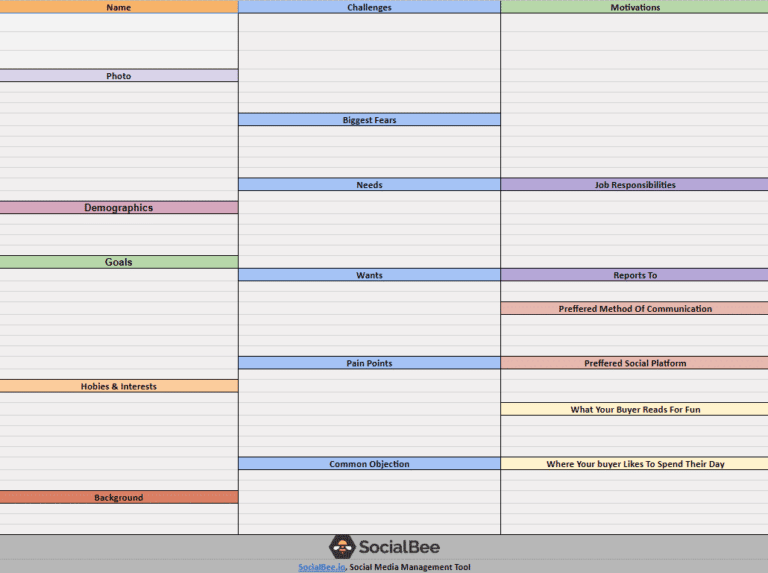
2. Encourage Your Followers to Interact
Essentially, your aim is to encourage interaction with your audience through brand-related social media engagement posts.
Create content that is easy to read, feels relatable for your audience, or sparks their interest. To drive audience engagement, you’ll want to ask questions and encourage feedback, conversations, and the exchange of opinions.
For example, you could try asking your audience to pick between two of your products, give their opinion on a challenge you’re dealing with, and ask them to share their feedback about their latest purchase, or anything else you see fit.
3. Respond to Comments and Messages Promptly
Responding quickly to comments and messages is key for social media marketing.
The faster you respond to comments and messages, the more people interact, feeling like you really care about what they have to say. This not only helps you bond with your followers but also turns them into devoted fans.
It’s also good for your brand’s reputation to handle issues swiftly. Keeping up with interactions helps keep everyone involved and fosters a sense of community around your brand.
PRO TIP:
SocialBee is your all-in-one social media management tool. It lets you handle and respond to all your social interactions across different platforms from one handy feed, making sure you never miss a message.
Monitor DMs, comments, and mentions on multiple accounts with SocialBee!
4. Leverage Social Media Communities and Groups
Using communities and groups on most social media platforms can expand your brand’s reach.
Join relevant groups and engage actively to connect with your audience. Share useful content and interact with influencers to build trust with your social media followers.
Starting your own Facebook group or Instagram broadcast channel can also create a dedicated community and boost engagement.
5. Post Strategically on Social Media
A strong social media strategy involves more than just quality content. Schedule your posts for when your audience is most active, using social media monitoring tools to identify these times.
Choose platforms based on where your audience is most engaged and the type of content you want to share.
To find the best times to post, analyze your social media insights for peak activity periods. Maintain a consistent posting schedule without overwhelming your audience.
Balance your content mix with promotional, educational, fun, and motivational posts to keep your audience interested and engaged. You should also use a content calendar to plan and organize your posts strategically.
Automating your content distribution tasks with social media management tools can also help you save several hours every week, without compromising the quality of work.
6. Post More Videos
They say a picture is worth 1,000 words, so you can imagine the impact a video has on users!
If you’ve been active on social media recently, you probably noticed the explosion of Reels and videos of all types. People love interactive content, which is why videos are a great way to speak directly to your audience.
You can focus on boosting social media engagement by:
- Speaking to your audience openly on camera: Share personal stories to create a genuine connection.
- Creating tutorials related to your brand: Ensure they solve common problems your audience faces.
- Posting lifestyle videos: Showcase how your products fit into everyday life.
- Hosting a live Q&A: Promote the event in advance and encourage your audience to submit questions beforehand.
- Sharing user-generated video content: Feature videos from your customers and thank them for their support.
- Running video contests and giveaways: Encourage likes, shares, and comments on video entries to increase engagement.
- Highlighting customer testimonial videos: Share authentic video reviews to build trust.
- Posting behind-the-scenes videos: Give a sneak peek into your company’s daily operations or event preparations.
- Using eye-catching thumbnails: Create attractive and relevant thumbnails to grab attention and increase video views.
- Writing compelling video titles and descriptions: Craft interesting titles and descriptions that encourage viewers to watch and interact.
7. Diversify Your Social Media Content
A study conducted by Microsoft Corporation shows that people start to lose focus after eight seconds. A goldfish has an attention span of about nine seconds, but that’s just some food for thought.
With so much information around us, our brains act as shields against the constant content wave. For your social media strategy, this means diversifying your posts to engage your audience.
Instead of just promotional content, create a varied content plan that educates, entertains, and sells.
For example, you can develop the following content categories:
- Promotional: Share the launch details of a new product with images and key features or some updates about exclusive deals.
- Educational: Create step-by-step tutorials related to your products or services.
- Fun: Share behind-the-scenes photos or videos from your office or events or industry-related memes.
- Motivational: Share quotes that resonate with your brand and audience.
- Industry-specific: Share the latest news and developments in your industry.
Once you have content categories, it’s time to schedule them throughout the week—motivational posts on Monday, promotional content on Wednesday, and so on.
PRO TIP:
SocialBee‘s content categories feature allows you to organize your posts into folders (based on specific topics) and schedule them at different times during the week.
By keeping different content types (promotional, educational, quotes, etc.) in separate categories, you can easily ensure a good mix of content goes out to your audience. This helps avoid overwhelming them with the same kind of post and keeps things interesting.
Moreover, SocialBee can track the performance of your content categories. This lets you see which types of content resonate most with your audience, allowing you to refine your strategy and tailor your content creation to what works best.
10 Social Media Engagement Posts Ideas
Generating engagement on social platforms keeps your brand top-of-mind and active in the community, building trust and expanding your network.
To achieve this, your content must spark curiosity, attention, and emotion, keeping your audience engaged. If you need inspiration, we’ve got you covered!
Here are 10 engaging post ideas you can add to your social platforms:
- Posts AMAs (ask me anything)
- Share “fill in the blanks” and “caption this” posts
- Create a weekly series
- Run a contest or giveaway on your social media accounts
- Post content on Facebook, Instagram and TikTok Stories
- Share how-to posts and tutorials
- Create memes and fun posts
- Run social media exclusive deals
- Post polls and questions
- Promote user-generated content
Now, let’s explore them in detail!
1. Post AMAs (Ask Me Anything)
One great way to boost your engagement is through AMAs (Ask Me Anything) posts, which you can add to your social media feed or stories section.
Encouraging your audience to connect with you by sharing their curiosities related to your brand will grow your comment section significantly.
Here’s an example of such social media post from Radford University:
Replying to comments on the spot or a few days later are both great social media strategies to consider. Engagement grows as you keep threads active, yet coming back to a post a few days after it’s been inactive can help you get the spotlight back on.
2. Share “Fill in the Blanks” and “Caption This” Posts
Another way to boost your engaging social media posts is through “Fill in the Blanks” games, which is a type of interactive content that requires users to leave comments and sparks their interest in the process.
If you’re a business and want to promote your brand, you can opt for posts like these:
- My favorite product from XYZ is ___.
- I always use XYZ’s product before ___.
- If I were to gift an item from XYZ to my best friend, it would be ___.
- The most surprising benefit of using XYZ’s product is ___.
- I can’t start my day without ___ from XYZ.
- XYZ’s product makes my life easier by ___.
- The first time I tried XYZ’s product, I felt ___.
- My go-to XYZ product for special occasions is ___.
- The best place to use XYZ’s product is ___.
- I would recommend XYZ’s product to someone who ___.
“Caption This” posts usually speak to younger audiences, as they encourage users to come up with something funny or relatable to the picture you’ve shared.
Essentially, people will meme your post in the comment section, which can spark a lot of attention and interest from other users who find the thread funny and love your post.
3. Create a Weekly Series
To keep your audience engaged, you’ll want to post relevant and regular content. You can do so by creating weekly series.
Here are some ideas of weekly series:
- Create a featured product of the week
- Share a blog post every week
- Offer a special deal every Saturday
- Do something similar to a throwback Thursday
- Feature a star employee weekly
Here’s an example of weekly series:
Essentially, anything that you can repeat every week and makes sense for your audience to find out more about is a good idea, because it enables you to stay consistent and creates a sense of anticipation among your audience.
Don’t forget to be creative and have fun with your posts on your social platforms.
4. Run a Contest or Giveaway on Your Social Media Platforms
Considering that everybody loves free stuff, social media giveaways are a great way to increase social media engagement and grow your follower base.
In exchange for likes, tags, reposts, and follows, both big and small brands agree to send out free products and services. It’s a win-win situation, and everybody loves it!
Here’s an example of a social media giveaway:
Set up a giveaway by choosing a product or service that acts as the prize, such as products from your latest collection, a free month for one of your best-selling services, or a pre-paid city break, and make a social media post about it.
Allow some time, usually about two weeks or up to a month for your audience to engage with it and follow the steps required to enter the contest.
When you’ve got the winner, announce it publicly and keep your end of the rope, meaning that you’re going to send out the prize. You can ask the lucky contestant to certify for you and let everyone know that you’re a trustworthy brand.
5. Post Content on Facebook, Instagram and TikTok Stories
Along with social media engagement posts, Stories are one the best ways to connect with your audience and maintain an open line of communication with your followers.
Through Stories, you get to share events and ideas to the tiniest detail, as you don’t have to prepare a post for everything you want to communicate. You can share how your day went, repost something you find relatable, or further promote other posts on your feed.
Here’s an example of Story that generates engagement:
As seen above, you can use stories to engage with your audience on a deeper level by asking questions with multiple answers, doing yes or no quizzes, Q&A sessions, sharing memories, “Did You Know?” contests, or other similar stories and polls.
6. Share How-to Posts and Tutorials
Among the most popular posts on social media are tutorials and how-to posts. Essentially, these are posts that aim to educate your audience regarding your offering.
Whether you’re a travel influencer, a food delivery company, an online clothing store, a service provider, or anything at all, tutorials are a great way to attract an active follower base and keep the ones you have loyal to you.
Here’s an example of a social media tutorial:
Usually, a series of pictures or short videos work best when it comes to explaining to your audience how to use your product or how to do something you’re promoting.
You can either film yourself explaining a step-by-step approach or create a post dedicated entirely to this purpose.
7. Create Memes and Fun Posts
Throughout this decade, memes rose from an internet-exclusive comedy genre to a whole humor culture. Although we like to joke about it, memes are one of the best ways to address the young generation.
If you want an active, engaged audience, you’ll want to pay more attention to fun content, especially social media memes. The more relatable they are, the better.
Here’s an example of a meme you can share on social media:
People react and interact with content that speaks to them on a deeper level, such as acknowledging a common struggle.
For example, if you’re a fashion retailer, you could post a picture describing a situation where you make up a whole outfit in your head, but it looks chaotic when you try it on.
Caption it with something relatable, and your social media engagement post is likely to go viral!
8. Run Social Media Exclusive Deals
Social media success depends on engagement. Boost it by connecting personally with your audience online and proving your content offers tangible benefits. Nothing drives customer loyalty more than exclusivity.
Here are five examples of social media exclusive deals:
- Special discounts
- Promo codes
- Free shipping
- Free e-books
Take a look at an example of a special discount:
People love to be repaid for their active engagement, so receiving promo codes, vouchers or additional gifts will make them feel appreciated.
Needless to say, you’ll surely help yourself in the process too, as you’ll notice a boost in sales and an increased engagement!
9. Post Polls and Questions
Polls and questions are fun ways to learn more about your followers or let them learn more about you.
Some ideas for polls are:
- I am a morning person/ night owl.
- I usually do cereal first/ I usually pour the milk first.
- I prefer the right/ left dress in the picture.
- I’d rather go to the XYZ business for lunch/ dinner.
- I find the XYZ company open-minded/ conservative.
Take a look at this poll shared by the Mailbird marketing team:
Get creative and have fun! This is your chance to share more about yourself and gain valuable insights about your followers. Ask open-ended questions and read as many responses as possible to understand your audience better.
10. Promote User-Generated Content
User-generated content is any piece of material that comes from customers. It can be a review or testimonial, a video reply to something you’ve talked about, the product of a recipe you’ve shared, or anything similar.
Here’s an example of user-generated content:
User-generated content acts as social proof—it promotes the positive experiences other customers had with your brand. It improves credibility and encourages other prospects to give your products/services a try.
Top 5 Social Media Engagement Tools to Use
You know by now how important it is to keep your audience engaged. To help you out, here are five top-notch tools that can make your job easier.
Each of these tools offers unique features tailored for social media managers who want to spark conversations, track engagement, and keep their content fresh and exciting.
Here are our social media engagement tool recommendations:
- SocialBee
- Hootsuite
- BuzzSumo
- Sprout Social
- Buffer
1. SocialBee
SocialBee is a handy AI-powered tool that helps you manage social media content across different platforms.
It focuses on creating, scheduling, and recycling content, so you can keep your audience engaged without always having to come up with new stuff.
One of its coolest features is the Social Inbox, which brings together messages and comments from all your social media accounts into one dashboard. This makes it super easy to manage and respond to everything in one place, ensuring you never miss a message.
Monitor conversations from one unified dashboard with SocialBee.
What makes it special? Here’s a breakdown of the key social media engagement features that SocialBee offers:
- Multi-platform support: Manage your social media tasks across a variety of platforms like Facebook, X (Twitter), LinkedIn, Instagram, Threads, Pinterest, TikTok, YouTube, Google Business Profile, and Bluesky.
- AI features: SocialBee’s AI Post Generator helps you create captivating social media captions and images. With a wealth of over 1,000 AI prompts, it empowers you to generate high-quality posts that resonate with your audience and align with your brand’s identity.
- Universal posting: SocialBee allows you to plan your content for any social media platform. With Universal Posting, you can easily post on networks not directly integrated with SocialBee, like Threads, WhatsApp, Facebook groups, Mastodon, and many others.
- Visual content calendar: Our tool helps you visually plan out your posts, giving you a clear picture of what your content schedule looks like over time. It’s perfect for ensuring you have a good mix of topics and maintaining a steady flow of posts.
- Content categories: Keep your posts organized by sorting them into different categories based on their topics. This helps you stay on track with your content strategy and makes sure you’re covering all the bases.
- Content customization: Fine-tune your posts for each social media platform. This means tweaking your content to match the unique style and audience of each site, which can really boost how much interaction each post gets.
- Post expiration: Set your posts to expire after a certain time or after they’ve been shared a lot. This keeps your feed fresh and engaging by preventing old or over-shared content from lingering too long.
- Evergreen scheduling: Automatically repost your best content at just the right times. This not only saves you time but also ensures that great posts get seen by people who might have missed them the first time around.
- Best posting time suggestions: SocialBee can suggest the best times to post based on when your content has performed well in the past. This takes the guesswork out of scheduling and helps you hit your audience when they’re most active.
- Social Inbox: Manage all your interactions from various platforms in one spot. This makes it much easier to keep up with messages, comments, and mentions, ensuring you don’t miss a beat in conversations with your audience.
- Social media analytics: Dive into detailed social media analytics about how your posts are doing. You can track everything from overall engagement to how fast your follower count is growing, giving you valuable insights to fine-tune your strategy.
- Team collaboration: Collaborate with your team seamlessly within SocialBee. Assign tasks, share feedback, and streamline your social media management process to ensure everyone is on the same page and working towards the same goals.
Pros:
|
Cons:
|
Pricing:
|
2. Hootsuite
Hootsuite is another favorite among social media marketers because it brings together everything you need in one spot. With this social media engagement platform, you can schedule your posts ahead of time, keep an eye on your engagement, and check how well your content is performing.
Plus, with features like social listening and options for team collaboration, it’s really helpful for businesses that want to keep their social media performance strong.
What makes it special? Hootsuite makes it easier for businesses to handle their social media interactions with its smart social inbox. This tool includes automatic language detection and smart routing, which directs incoming messages to the appropriate team member based on their relevance.
If necessary, you can manually adjust these assignments with just a few clicks, allowing for greater control over how messages are managed.
Pros
|
Cons
|
Pricing
|
3. BuzzSumo
BuzzSumo is a powerful social media engagement tool with great features for content research, influencer marketing, and social media analytics.
It helps users discover trending content, analyze social media performance, and monitor their brand’s online presence.
What makes it special? The platform’s comprehensive analytics provide detailed insights into content performance, engagement metrics, and competitor strategies.
You can track which types of content perform best and at what times, helping you refine your content strategy for maximum impact.
Pros
|
Cons
|
Pricing
|
4. Sprout Social
Sprout Social is your comprehensive solution for social media management. It allows you to schedule posts, analyze performance, and effortlessly engage with your audience.
What makes it special? The social media management plaform allows businesses to monitor and analyze conversations across social platforms, providing insights into public sentiment and emerging trends.
The platform’s social listening tools enable real-time engagement, helping businesses respond promptly and effectively to their audience.
Pros
|
Cons
|
Pricing
|
5. Buffer
Buffer is another social media engagement software ideal for entrepreneurs and small businesses aiming to boost engagement by simplifying their social media tasks. It streamlines content creation and scheduling, allowing users to efficiently plan and publish engaging content across various platforms.
What makes it special? Buffer’s interface stands out for its simplicity and ease of use compared to other digital marketing tools. Designed to be intuitive, it’s accessible for anyone looking to manage their social media presence effectively.
Pros:
|
Cons:
|
Pricing:
|
Frequently Asked Questions
A rate between 1% and 5% is considered healthy. However, a good social media engagement rate can vary significantly depending on the platform, the industry, and the specific audience demographics, but generally.
For platforms like Instagram and Facebook, anything above 1% is often seen as good, while X (Twitter) might have lower average rates.
The wheel of social media engagement is a handy framework that breaks down the essential activities that allow you to increase engagement in the online space.
The wheel of social media engagement includes:
- Creating content, where you craft posts that resonate with your audience;
- Curating content, which involves picking and sharing posts from others that your followers will find interesting;
- Interacting, where you reply to comments and join conversations to connect personally with your audience;
- Promoting, using ads or shout-outs to reach a wider audience;
- Listening, where you keep an ear out for what people are saying about you or your industry to better respond to their needs.
These elements work together to help you build a lively and engaged community online.
Posts that generally receive the most engagement on social media tend to include compelling visual content such as eye-catching images, videos, and infographics.
These visuals attract more attention and are more likely to be shared, enhancing a brand’s social media presence.
Additionally, posts that prompt users to interact, whether through questions, calls-to-action, or invitations to send direct messages, also see higher engagement rates.
These strategies encourage active participation and conversation, fostering a stronger connection between the brand and its audience.
Improve Your Social Media Engagement Strategy
That was..a lot! If you’ve reached this point in the article, you’re now one of the few people who knows the importance of a social media strategy and how to create fun and entertaining social media engagement posts, so kudos to you!
However, if you feel that you may require extra help with your social media content creation and distribution tasks, SocialBee is here to help you maintain a consistent posting schedule with less effort.
Start your free 14-day trial today to create, schedule, and share content on all your platforms from one intuitive dashboard!

